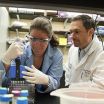INFORMATION:
At a glance
What is Mindfulness-Oriented Recovery Enhancement (MORE)?
MORE is designed to train people to respond differently to pain, stress and drug-related triggers.
MORE targets the underlying processes involved in chronic pain and addiction by combining three therapeutic components: mindfulness training, reappraisal and savoring.
Mindfulness involves training the mind to increase awareness, gain control over one's attention and regulate automatic habits.
Reappraisal is the process of reframing the meaning of a stressful or adverse event in such a way to see it as purposeful or growth promoting.
Savoring is the process of learning to focus attention on positive events to increase one's sensitivity to naturally rewarding experiences, such as enjoying a beautiful nature scene or experiencing a sense of connection with a loved one.
Utah study: Mindfulness intervention boosts brain activation for healthy pleasures
University of Utah professor Eric Garland developed Mindfulness-Oriented Recovery-Enhancement
2014-12-05
(Press-News.org) (Salt Lake City) --How can people who are dependent on prescription opioids reduce their cravings? Learn to enjoy other aspects of their lives.
That's the key finding in a new study published in the Journal of Behavioral Medicine by Eric L. Garland, associate professor at the University of Utah College of Social Work. Garland and colleagues studied how an intervention program for chronic pain patients called Mindfulness-Oriented Recovery Enhancement (MORE) decreased patients' desire for prescription drugs.
The MORE intervention concentrates on helping people to recover a sense of meaning and fulfillment in everyday life, embracing its pleasures and pain without turning to substance use as a coping mechanism. It integrates the latest research on addiction, cognitive neuroscience, positive psychology and mindfulness. Participants in Garland's study received eight weeks of instruction in applying mindfulness-oriented techniques to alleviate pain and craving while strengthening positive emotions and the sense of reward and meaning in life.
For example, to enhance their sense of reward in life, participants in Garland's study were taught a "mindful savoring practice," in which they focused attention on pleasant experiences such as a beautiful nature scene, sunset or feeling of connection with a loved one. In a meditation session, participants were taught to focus their awareness on colors, textures and scents of a bouquet of fresh flowers and to appreciate joy arising from the experience. As part of their daily homework, they were then asked to practice the meditation technique as a way to enjoy other pleasant life experiences.
Results from Garland's new research shows that after a sample of chronic pain patients misusing opioids went through MORE, they exhibited increased brain activation on an EEG to natural healthy pleasures. The more their brains became active in response to natural healthy pleasure, the less the patients craved opioids.
"These findings are scientifically important because one of the major theories about how and why addiction occurs asserts that over time drug abusers become dulled to the experience of joy in everyday life, and this pushes them to use higher and higher doses of drugs to feel happiness," said Garland.
"This study suggests that this process can be reversed. We can teach people to use mindfulness to appreciate and enjoy life more, and by doing that, they may feel less of a need for addictive drugs. It's a powerful finding."
Garland's latest study builds on earlier work published in February in The Journal of Consulting and Clinical Psychology, in which the MORE intervention was found to reduce opioid misuse among a sample of chronic pain patients compared to another sample of chronic pain patients participating in a conventional support group.
The results are of particular interest in Utah, which claims one of the highest prescription drug abuse rates in the U.S. According to the most recent statistics available from the state Division of Substance Abuse and Mental Health, Utah ranks eighth in the U.S. for its number of deaths attributed to prescription drug overdose.
Garland, who developed MORE intervention, noted the method is also being tested on people who want to quit smoking or lose weight.
ELSE PRESS RELEASES FROM THIS DATE:
Evidence suggests California's drought is the worst in 1,200 years
2014-12-05
As California finally experiences the arrival of a rain-bearing Pineapple Express this week, two climate scientists from the University of Minnesota and Woods Hole Oceanographic Institution have shown that the drought of 2012-2014 has been the worst in 1,200 years.
Daniel Griffin, an assistant professor in the Department of Geography, Environment and Society at the University of Minnesota, and Kevin Anchukaitis, an assistant scientist at Woods Hole Oceanographic Institution, asked the question, "How unusual is the ongoing California drought?" Watching the severity of ...
Genetic errors linked to more ALS cases than scientists had thought
2014-12-05
Genetic mutations may cause more cases of amyotrophic lateral sclerosis (ALS) than scientists previously had realized, according to researchers at Washington University School of Medicine in St. Louis and Cedars-Sinai Medical Center in Los Angeles. The scientists also showed that the number of mutated genes influences the age when the fatal paralyzing disorder first appears.
ALS, also known as Lou Gehrig's disease, destroys the nerve cells that control muscles, leading to loss of mobility, difficulty breathing and swallowing, and eventually paralysis and death. Understanding ...
Propranolol in infantile hemangioma: Indication of major added benefit in some patients
2014-12-05
The Institute for Quality and Efficiency in Health Care (IQWiG) investigated in a dossier assessment whether propranolol offers an added benefit in comparison with the appropriate comparator therapy in infants with proliferating infantile haemangioma (sometimes called "strawberry mark").
According to the findings, there is an indication of major added benefit of propranolol in some children, i.e. those with haemangioma with a risk of permanent scars or disfigurement. In contrast, an added benefit is not proven for children with life- or function-threatening haemangioma, ...
Type 2 diabetes risk starts in pregnancy
2014-12-05
The vicious cycle of diabetes describes a scenario where people are becoming fatter, often with elevated levels of glucose, and at increased risk for women to develop gestational diabetes (GDM). Intrauterine exposure to GDM, itself, is a major risk factor for later obesity and diabetes, thus perpetuating this maternal-offspring cycle of disease.
Researchers from Lund University have published an overview of evidence across the past few decades in the journal Diabetes, Metabolic Syndrome and Obesity: Targets and Therapy. They emphasize the need to update diabetes prevention ...
An unholy alliance -- Colon cancer cells in situ co-opt fibroblasts in surrounding tissue to break out
2014-12-05
It means cancer "in place" but a carcinoma "in situ" often does not want to keep its place. Standing between a cancer cell in situ and the surrounding tissue of fibroblasts and extracellular matrix is the basement membrane, a thin sheet of fibers that normally cradles the cells above it. The basement membrane is also the frontline physical barrier that keeps primary tumors from spreading into the matrix below. Perforating the basement membrane is a cancer cell's first move toward invasion, but how? Fibroblasts are most commonly found in connective tissue that synthesizes ...
Blood brain barrier on a chip could stand in for children in pediatric brain research
2014-12-05
In the human brain, the BBB is not the Better Business Bureau but the blood brain barrier and the BBB is serious business in human physiology. The human BBB separates circulating blood from the central nervous system, thus protecting the brain from many infections and toxins. But the BBB also blocks the passage of many potentially useful drugs to the brain and it has long stymied scientists who want to learn more about this vital tissue because of the lack of realistic non-human lab models. Even less is known about the BBB in children. There are significant structural and ...
'Alzheimer's in a Dish' model induces skin cells into neurons expressing amyloid-beta
2014-12-05
VIDEO:
This 19-second time lapse video shows the first six hours of neuronal conversion of skin fibroblasts from a patient with Alzheimer's disease.
Click here for more information.
The search for a living laboratory model of human neurons in the grip of Alzheimer's disease (AD)--the so-called "Alzheimer's in a dish"--has a new candidate. In work presented at the ASCB/IFCB meeting in Philadelphia, Håkan Toresson and colleagues at Lund University in Sweden report success ...
Screening for matrix effect in leukemia subtypes could sharpen chemotherapy targeting
2014-12-05
Location, location, location goes the old real estate proverb but cancer also responds to its neighborhood, particularly in the physical surroundings of bone marrow cells where human myeloid leukemias arise and where, according to two Harvard bioengineers, stiffness in the surrounding extracellular matrix (ECM) can predict how cancer subtypes react to chemotherapy. Correcting for the matrix effect could give oncologists a new tool for matching drugs to patients, the researchers say.
In work to be presented at the ASCB/IFCB meeting in Philadelphia, Jae-Won Shin and David ...
Rescuing the Golgi puts brakes on Alzheimer's progression
2014-12-05
Alzheimer's disease (AD) progresses inside the brain in a rising storm of cellular chaos as deposits of the toxic protein, amyloid-beta (Aβ), overwhelm neurons. An apparent side effect of accumulating Aβ in neurons is the fragmentation of the Golgi apparatus, the part of the cell involved in packaging and sorting protein cargo including the precursor of Aβ. But is the destruction the Golgi a kind of collateral damage from the Aβ storm or is the loss of Golgi function itself part of the driving force behind Alzheimer's? This was the question for Yanzhuang ...
Gravity: It's the law, even for cells
2014-12-05
VIDEO:
Nucleoli (green), small liquid-like nuclear bodies, are kept small and afloat by a fine actin mesh. When the mesh breaks, the nucleoli quickly being to fall and coalesce into larger...
Click here for more information.
Everybody knows that cells are microscopic, but why? Why aren't cells bigger? The average animal cell is 10 microns across and the traditional explanation has been cells are the perfect size because if they were any bigger it would be difficult to get enough ...
LAST 30 PRESS RELEASES:
Statins significantly reduce mortality risk for adults with diabetes, regardless of cardiovascular risk
Brain immune cells may drive more damage in females than males with Alzheimer’s
Evidence-based recommendations empower clinicians to manage epilepsy in pregnancy
Fungus turns bark beetles’ defenses against them
There are new antivirals being tested for herpesviruses. Scientists now know how they work
CDI scientist, colleagues author review of global burden of fungus Candida auris
How does stroke influence speech comprehension?
B cells transiently unlock their plasticity, risking lymphoma development
Advanced AI dodel predicts spoken language outcomes in deaf children after cochlear implants
Multimodal imaging-based cerebral blood flow prediction model development in simulated microgravity
Accelerated streaming subgraph matching framework is faster, more robust, and scalable
Gestational diabetes rose every year in the US since 2016
OHSU researchers find breast cancer drug boosts leukemia treatment
Fear and medical misinformation regarding risk of progression or recurrence among patients with breast cancer
Glucagonlike peptide-1 receptor agonists and asthma risk in adolescents with obesity
Reviving dormant immunity: Millimeter waves reprogram the immunosuppressive microenvironment to potentiate immunotherapy without obvious side effects
Safety decision-making for autonomous vehicles integrating passenger physiological states by fNIRS
Fires could emit more air pollution than previously estimated
A new way to map how cells choose their fate
Numbers in our sights affect how we perceive space
SIMJ announces global collaborative book project in commemoration of its 75th anniversary
Air pollution exposure and birth weight
Obstructive sleep apnea risk and mental health conditions among older adults
How talking slows eye movements behind the wheel
The Ceramic Society of Japan’s Oxoate Ceramics Research Association launches new international book project
Heart-brain connection: international study reveals the role of the vagus nerve in keeping the heart young
Researchers identify Rb1 as a predictive biomarker for a new therapeutic strategy in some breast cancers
Survey reveals ethical gaps slowing AI adoption in pediatric surgery
Stimulant ADHD medications work differently than thought
AI overestimates how smart people are, according to HSE economists
[Press-News.org] Utah study: Mindfulness intervention boosts brain activation for healthy pleasuresUniversity of Utah professor Eric Garland developed Mindfulness-Oriented Recovery-Enhancement




